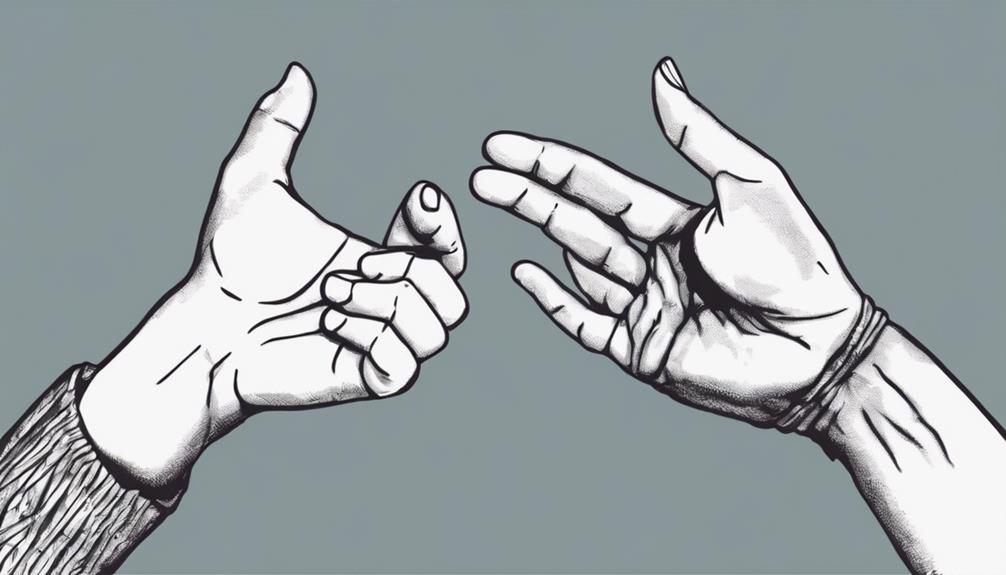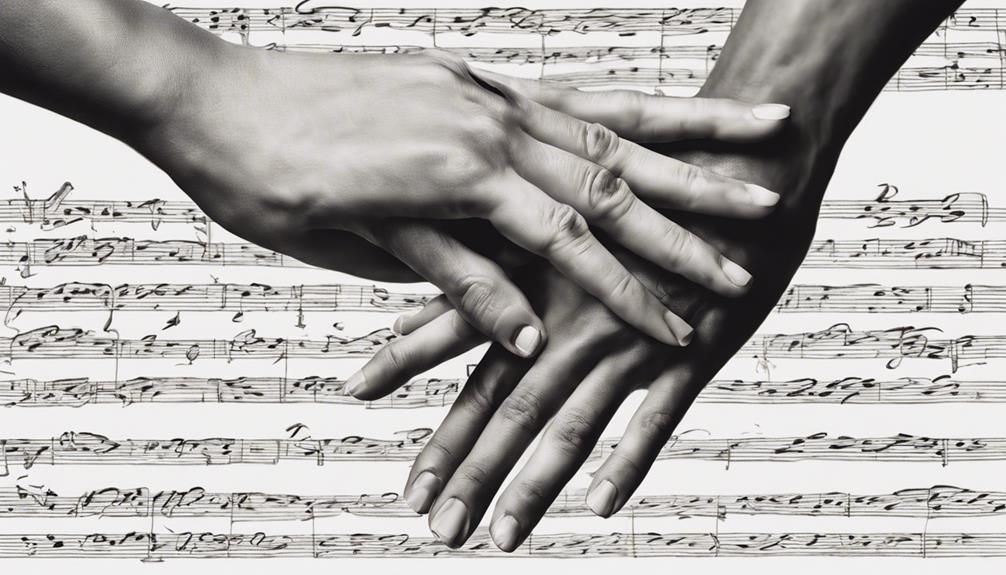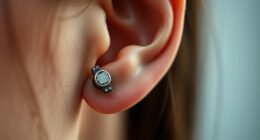When it comes to learning how to sign ‘Fart’ in American Sign Language, we explore the silent yet expressive art of communication with a hint of humor.
Curious about the gestures that capture this common bodily function in ASL? Let's explore the intricacies of handshapes, movements, and facial cues that bring this sign to life.
Join us on this journey as we uncover the nuances and techniques that make signing 'Fart' an engaging and memorable experience in the realm of American Sign Language.
Key Takeaways
- Master handshape and movement precision for effective 'fart' signing.
- Emphasize speed, fluidity, and facial expressions for impactful communication.
- Practice consistently to develop muscle memory and avoid mistakes.
- Respect cultural sensitivity and sign language etiquette for inclusive interactions.
Understanding the Sign for 'Fart
When learning American Sign Language, understanding the sign for 'Fart' is both humorous and practical in expanding our ASL vocabulary. The sign involves the dominant hand bending and unbending under the pinkie side of the non-dominant fist. To add emphasis, puffing the cheek and forcing air through the corner of the mouth can enhance the sign.
Different versions of the sign exist, with variations in handshapes and movements, showcasing the creativity within ASL. Resources like Dr. William Vicars' Lifeprint.com and ASL University can aid in mastering signs like 'Fart'.
Understanding this sign not only adds a playful element to communication but also strengthens our language skills in ASL. By incorporating gestures with the non-dominant hand, we can effectively convey the concept of 'Fart' in conversations, showcasing our proficiency and fluency in American Sign Language.
Mastering the Handshape

Mastering the handshape for the ASL sign for 'fart' involves forming a specific hand configuration with the non-dominant hand and executing a precise movement with the dominant hand. The non-dominant hand should be in an A or S handshape, serving as the base for the sign.
The dominant hand, positioned under the pinkie side of the non-dominant fist in a bent manner, represents the escaping gas. To accurately depict the action of passing gas, the dominant hand unbends and bends once. This movement should be swift yet controlled to convey the concept effectively.
Remember, in sign language, each handshape and movement is crucial for conveying the intended meaning accurately. Therefore, mastering the handshape is fundamental to signing 'fart' fluently in American Sign Language.
Perfecting the Movement
As we focus on perfecting the movement of the 'fart' sign in ASL, it's crucial to pay attention to the hand shape, ensuring it accurately reflects the concept being signed.
Speed and fluidity play a significant role in conveying the sign effectively, emphasizing the natural flow of the gesture.
Additionally, incorporating the right facial expressions can enhance the overall impact and clarity of the sign.
Hand Shape Importance
Perfecting the movement in the American Sign Language sign for 'fart' requires precise hand shape and coordinated finger movements to accurately convey the concept.
The hand shape involves a non-dominant A or S handshape with the dominant hand positioned under the pinkie side of the non-dominant fist. To execute the movement effectively, the dominant hand must unbend and bend once to mimic gas escaping, starting by opening the pinkie, ring, and middle fingers before reversing the motion.
Adding emphasis to the sign can be done by puffing a cheek and forcing air through the corner of the mouth, enhancing the visual and expressive elements.
Mastering the specific hand shape and movement details is crucial for clear communication and effective expression when signing 'fart' in American Sign Language.
Speed and Fluidity
Improving the speed and fluidity of signing 'fart' in ASL involves focusing on smooth hand movements without pauses. To perfect the movement, consider the following:
- Practice transitioning between hand shapes seamlessly to create a natural flow in the sign.
- Work on the coordination of both hands to ensure synchronized movements for a polished sign.
- Avoid jerky or abrupt motions when signing 'fart' to maintain the fluidity of the sign.
- Consistent practice and attention to detail will help in mastering the speed and fluidity of signing 'fart' in ASL.
Facial Expression Impact
Enhancing the comedic or playful nature of the sign 'fart' in American Sign Language involves incorporating precise and expressive facial expressions.
When signing 'fart' in ASL, exaggerating the eyes widening, mouth forming an 'O' shape, and a slight smile can amplify the humorous intent behind the sign. These facial expressions not only add emphasis but also provide context, making the sign more engaging and memorable.
By mastering the movement and accompanying facial expressions, signers can effectively convey the lightheartedness and joviality associated with the sign 'fart.'
Attention to facial expression impact ensures that the humor is effectively communicated, enriching the overall ASL experience for both the signer and the audience.
Adding Facial Expressions

Incorporating facial expressions adds depth and humor to the American Sign Language sign for 'fart.' When signing 'fart' in ASL, utilizing facial expressions can significantly enhance the overall meaning and tone of the sign.
Here are four ways to effectively incorporate facial expressions into your ASL sign for 'fart':
- Puff Your Cheeks: Inflate your cheeks as if holding in air, then release them suddenly to mimic the act of passing gas.
- Mimic the Sound: Use your facial expressions to convey the sound associated with farting, adding a playful and humorous element to the sign.
- Express Discomfort: Contort your face to show discomfort or surprise, emphasizing the physical act of passing gas in a lighthearted manner.
- Convey Playfulness: Use a mischievous or playful expression to capture the humorous nature of the sign for 'fart' in ASL.
Incorporating Humor Appropriately

To effectively integrate humor in American Sign Language, it is crucial to gauge the appropriate timing and delivery based on the context and audience. When incorporating humor into ASL, it's important to strike a balance between being funny and respectful. Here is a guide to help you navigate the use of humor in sign language effectively:
| Dos | Don'ts |
|---|---|
| Use humor sparingly and appropriately | Overdo humor |
| Consider the context and audience | Disregard cultural sensitivities |
| Incorporate facial expressions and body language | Use offensive or inappropriate humor |
| Seek feedback from Deaf individuals or ASL instructors | Assume everyone will appreciate the humor |
Practicing With Confidence

Let's embrace those awkward moments and repeat the sign for 'fart' to strengthen our muscle memory.
Consistency in practice is key to building confidence in our signing skills.
Seeking feedback from experts and practicing in front of a mirror will help us refine our technique and enhance our fluency.
Embrace Awkward Moments
Embracing awkward moments and practicing the ASL sign for 'fart' with confidence can help to enhance your fluency in sign language. When dealing with potentially embarrassing signs, it's essential to approach them with a positive attitude.
Here are some tips to help you navigate awkward moments while learning ASL:
- Acknowledge the humor: Recognize that learning signs related to bodily functions can be amusing.
- Practice with support: Work on the sign in front of a mirror or with a supportive partner to build confidence.
- Express openly: Remember that ASL encompasses a wide range of concepts, including those that may initially feel uncomfortable.
- Maintain humor and openness: Approach learning the sign for 'fart' with a sense of humor and a willingness to embrace new experiences in sign language.
Repeat for Muscle Memory
Building muscle memory through repeated practice is essential for mastering the sign for 'fart' in American Sign Language. Each practice session reinforces the handshape and movement needed for the sign, enhancing fluency and accuracy.
By practicing the sign for 'fart' multiple times, we can strengthen our ability to recall it quickly and confidently when communicating. Consistent repetition is key to developing muscle memory, which is crucial for signing fluidly and without hesitation.
The more we repeat the sign, the more ingrained it becomes, boosting our confidence in using it effectively. Remember, muscle memory is a powerful tool in ASL signing, and by repeating the sign for 'fart' regularly, we can enhance our skills and proficiency in this expressive language.
Common Mistakes to Avoid

In signing 'fart' in American Sign Language, it's crucial to avoid using inappropriate or offensive gestures to accurately convey the concept respectfully. To ensure proper communication and understanding, here are common mistakes to avoid:
- Incorrect Handshape: Using the wrong handshape can lead to misunderstandings or offense. Make sure to use the appropriate handshape for 'fart' to convey the meaning clearly.
- Inaccurate Motion: The motion of the sign is essential in ASL. Ensure that your motion aligns with the concept of passing gas to avoid confusion.
- Facial Expressions: Maintaining respectful and appropriate facial expressions is key in sign language. Avoid making faces that may distract from the intended message.
- Lack of Context: Understanding when and how to use the sign 'fart' in context is crucial. Practice signing in various situations to grasp the full meaning and appropriate usage of the sign.
Cultural Context and Sensitivity

Understanding the cultural nuances and sensitivities surrounding signs like 'fart' in American Sign Language is essential for effective and respectful communication within the Deaf community. In ASL, signs related to bodily functions carry cultural significance and require a nuanced approach. Sensitivity to the Deaf community's perspective on such signs is paramount in language learning.
It's crucial to consider the cultural implications and etiquette of using signs like 'fart' to avoid unintentional disrespect. By being mindful of cultural norms and the diverse contexts in which ASL is used, we can enhance communication and foster understanding. Respectful use of signs related to bodily functions, including 'fart,' demonstrates awareness and consideration of the Deaf community's values.
Developing proficiency in signing involves not only mastering the physical gestures but also understanding the cultural contexts in which these signs are embedded. By incorporating cultural sensitivity into our ASL communication, we can promote inclusivity and effective interaction within the Deaf community.
Frequently Asked Questions
What Is the Sign for Fart in Asl?
We can show you the sign for 'fart' in ASL.
It involves using a non-dominant hand in an A or S handshape, with the dominant hand positioned under the pinkie side of the non-dominant fist.
The dominant hand then mimics gas escaping by unbending and bending once.
To add emphasis, puff a cheek and force air through the corner of the mouth while signing 'fart'.
There are variations in how this sign can be produced, each with unique techniques and visual elements.
How Do You Say Gas in Sign Language?
When signing 'gas' in American Sign Language (ASL), we use a fingerspelled abbreviation: G-A-S. This method is commonly used for technical or specific terms that don't have a designated sign.
Remember to maintain a clear and steady pace while fingerspelling to ensure understanding. Consistent practice with fingerspelling will help you become more proficient in signing various words that lack specific signs.
What Is Pee in Sign Language?
When signing 'pee' in American Sign Language, we use a closed dominant hand near the stomach, then quickly flick it forward. This gesture mimics the act of relieving oneself.
By adding facial expressions or sound effects, like an exaggerated relief sigh, you can enhance the sign's meaning.
How Do You Say How Are You Doing in American Sign Language?
We sign 'How are you doing?' in American Sign Language (ASL) by combining signs for 'HOW,' 'YOU,' and 'DOING' with proper facial expressions and body language.
The sign for 'HOW' involves tapping fingers on the chest twice, 'YOU' is pointing at the person addressed, and 'DOING' is a small circular hand motion.
Is Learning American Sign Language for ‘Eat’ Helpful for Understanding Other Signs?
Learning American Sign Language for “eat” from a stepbystep sign language tutorial is certainly helpful for understanding other signs. Once you grasp the basic movements and concepts, it becomes easier to expand your vocabulary and comprehension. Taking small steps with specific signs can lead to a better overall understanding.
Conclusion
In conclusion, mastering the sign for 'fart' in American Sign Language is like learning a new dance move. It takes practice, precision, and a touch of humor. By perfecting the handshape, movement, and facial expressions, one can confidently incorporate this sign into their ASL vocabulary.
Remember to approach learning with cultural sensitivity and practice with confidence to ensure effective communication. Keep practicing, and soon signing 'fart' will be as effortless as a graceful twirl on the dance floor.











